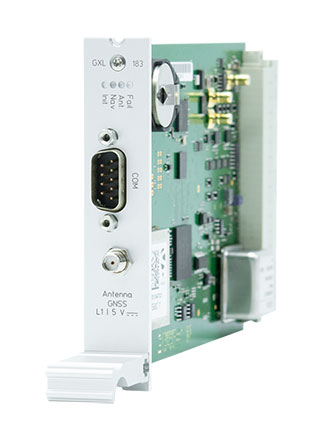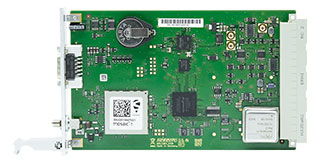IMS-GXL: Top-End GNSS Clock for High-Security Applications
Key Features


- Highly configurable pulse signals, including pulse-per-second and pulse-per-minute
- Free six-month access to the AtomiChron™ service with the purchase of an IMS-GXL clock
- Supports the premium AtomiChron® authentication service provided by Dutch geo-data specialists Fugro
- 448-channel GPS / Galileo / GLONASS / BeiDou receiver with wide selection of oscillators
Product Description
The IMS-GXL is a 448-channel satellite clock module with GNSS technology that has been developed from the ground up specifically for time and frequency synchronization purposes. The IMS-GXL provides a high-precision, high-accuracy time and frequency reference for your Meinberg IMS system and is designed to receive all civilian signals from the U.S. Global Positioning System (GPS), the European Galileo system, the Chinese BeiDou system, and the Russian GLONASS system, providing an impressive range of sources for your Meinberg system to be used anywhere in the world.
How It Works
The integrated GNSS receiver requires an external multi-band GNSS antenna to receive signals from GPS, Galileo, BeiDou, and GLONASS satellites.
Once the IMS-GXL is successfully initialized and synchronized, it distributes a 1PPS (pulse-per-second) reference clock signal and a 10 MHz reference frequency. These are then used by the IMS output modules to generate a wide variety of specific output signals used in a diverse range of applications. The precision and accuracy of the two aforementioned reference signals are critical in determining the corresponding precision and accuracy of the output signals.
The module also supports the IMS platform's MRS functionality (Multi Reference Source) to utilize all available reference sources for synchronization beyond the GNSS signals.
The support for the free OSNMA mechanism* and the premium AtomiChron® service** allows incoming GNSS signals to be tested for their plausibility and authenticity in order to effectively thwart spoofing attempts. If there is any doubt as to the authenticity of a GNSS message, the system falls back to a redundant reference source, but continues to monitor the GNSS messages so that they can be used as a reference source again once the manipulation is considered to have ended.
Use of Two IMS Receiver Modules
In systems equipped with two redundant IMS receiver modules, an RSC switchover module is used to switch
between the two reference sources. The RSC serves to switch over the pulse and frequency outputs and serial interfaces of the connected reference clocks.
* Support for the OSNMA mechanism will be introduced via a firmware update at a later date when the service officially goes live.
** The AtomiChron® service operated by Fugro N.V. requires a Service Agreement to be concluded with Meinberg and payment to be made in advance before it can be enabled for your IMS-GXL183 module.
Characteristics
| Receiver | 448-Channel GPS / Galileo / GLONASS / Beidou Multi-Band Receiver |
| Input Frequency |
GPS/QZSS
L1 C/A, P(Y): 1575.42 MHz L2C: 1227.60 MHz Galileo E1 OS B/C: 1575.42 MHz E1 E5a: 1165.45 MHz E1 E5b: 1207.14 MHz BeiDou B1I: 1561.098 MHz B2I: 1207.14 MHz B3I: 1268.52 MHz GLONASS L1OF: 1602 MHz + k*562.5 kHz L2OF: 1246 MHz + k*437.5 kHz |
| Status Indicators |
|
| Type of Antenna | GNMANTv2: Dual-Band Multi-Frequency Antenna for GPS, Galileo, GLONASS and BeiDou reception |
| Synchronization Time | Max. 1 minute in normal operating conditions
Max. 25 minutes (average 12 minutes) upon first initialization or in the absence of saved satellite data |
| Frequency Outputs | Frequency Synthesizer for arbitrary frequencies between 0.125 Hz and 10 MHz, adjustable phase, output via external modules such as IMS-BPE modules |
| Accuracy of Frequency Outputs | Accuracy dependent on oscillator (Standard: OCXO-SQ), see oscillator list |
| Pulse Outputs | Various programmable pulse signals (TTL levels), including pulse-per-second and pulse-per-minute, outputs over four discrete channels, delivery via external output modules (e.g., IMS-BPE). |
| Accuracy of Pulse Outputs | < ±50 ns (OCXO SQ, OCXO HQ, OCXO DHQ) |
| Interface | RS-232 interface for time string output and also for synchronization using time string input and PPS signal |
| Serial Time String Output | Baud Rates: 300, 600, 1200, 2400, 4800, 9600, 19200 Baud Framing: 7E1, 7E2, 7N2, 7O1, 7O2, 8E1, 8N1, 8N2, 8O1 Time String Formats: Meinberg Standard Time String , SAT, Uni Erlangen (NTP), SPA, Sysplex, RACAL, NMEA0183 (RMC,GGA,ZDA), Meinberg GPS, COMPUTIME, ION, Capture String |
| Output Control Options | Pulse, string, and frequency outputs can all either be enabled or disabled depending on clock sync state or left permanently enabled |
| Supported Timecode Formats |
Dedicated timecode output (DCLS/AM) via output module (e.g., IMS-BPE) and input capability via appropriate module (e.g., IMS-MRI-Modul) IRIG B002 (DCLS) / IRIG B122 (AM, 1 kHz carrier): 100pps, BCD time-of-yearIRIG B003 (DCLS) / IRIG B123 (AM, 1 kHz carrier): 100pps, BCD time-of-year, SBS time-of-day IRIG B006 (DCLS) / IRIG B126 (AM, 1 kHz carrier): 100pps, BCD time-of-year, year IRIG B007 (DCLS) / IRIG B127 (AM, 1 kHz carrier): 100pps, BCD time-of-year, year, SBS time-of-day IEEE1344 (AM, 1 kHz carrier): Code as per IEEE1344-1995, 100pps, BCD time-of-year, SBS time-of-day, IEEE1344 extensions for date, timezone, DST and leap seconds in "control functions" segment C37.118: as with IEEE1344, but with inverted prefix bit for UTC offset AFNOR NFS-87500 (AM with 1 kHz carrier/DCLS): Code as per AFNOR NFS-87500, 100pps, BCD time-of-year, full date, SBS time-of-day |
| Antenna Connector | SMA female connector |
| Backup Battery Type |
CR2032 (lithium button cell)
In the event of loss of power to the main system, this battery powers the real-time clock and also ensures that GNSS almanac data is properly buffered in RAM. Lifetime of lithium battery: Min. 10 years |
| Cable Type | Speedfoam 240HFJ max. length 70 m (230 ft) |
| Operating Voltage | +5 V DC |
| Current Draw | 1.1 A to 1.4 A (depends on oscillator option) |
| Supported Temperature | Operation: 0 to 55 °C (32 to 131 °F) Storage: -20 to 70 °C (-4 to 158 °F) |
| Supported Humidity | Max. 85 % (non-condensing) at 40 °C |
| Warranty | Three-year warranty |
| RoHS Status of Product | This product is fully RoHS-compliant. |
| WEEE Status of Product | This product is handled as a B2B (Business to Business) category product. To ensure that the product is disposed of in a WEEE-compliant fashion, it can be returned to the manufacturer. Any transportation expenses for returning this product (at end-of-life) must be covered by the end user, while Meinberg will bear the costs for the waste disposal itself. |
Downloads
Data Sheet
Short Info Sheet
Manuals
- Handbuch (deutsch) zur Zeit nicht verfügbar.
- For drivers, SDKs, tools and utilities, please check our Download Section





